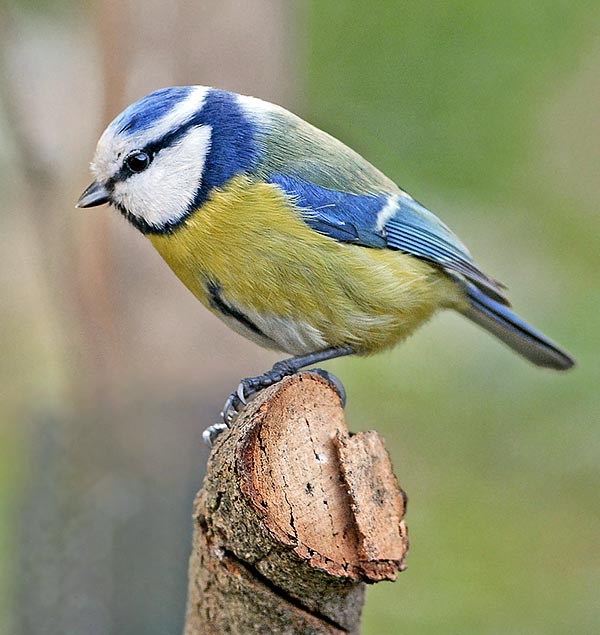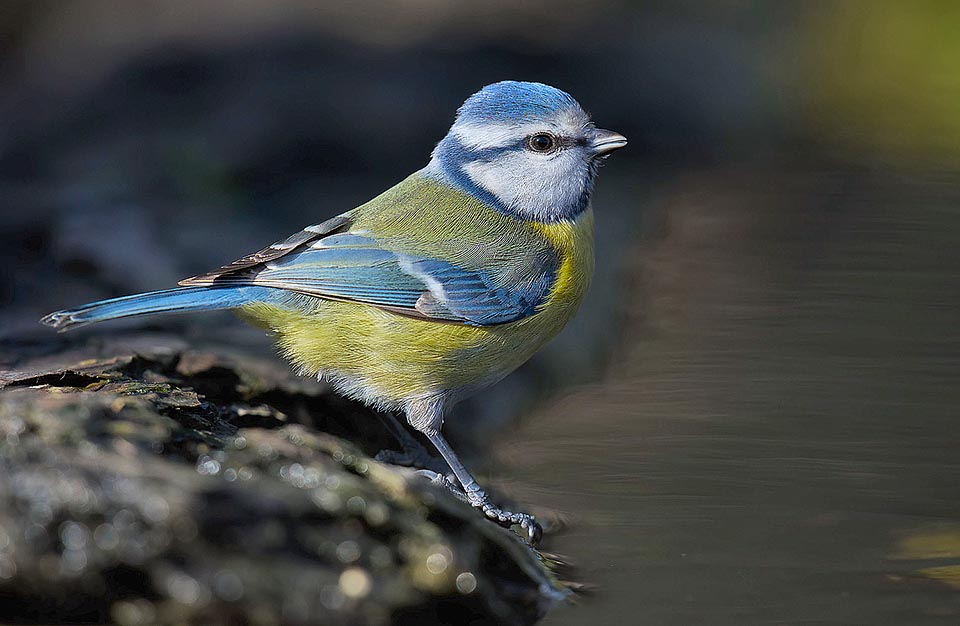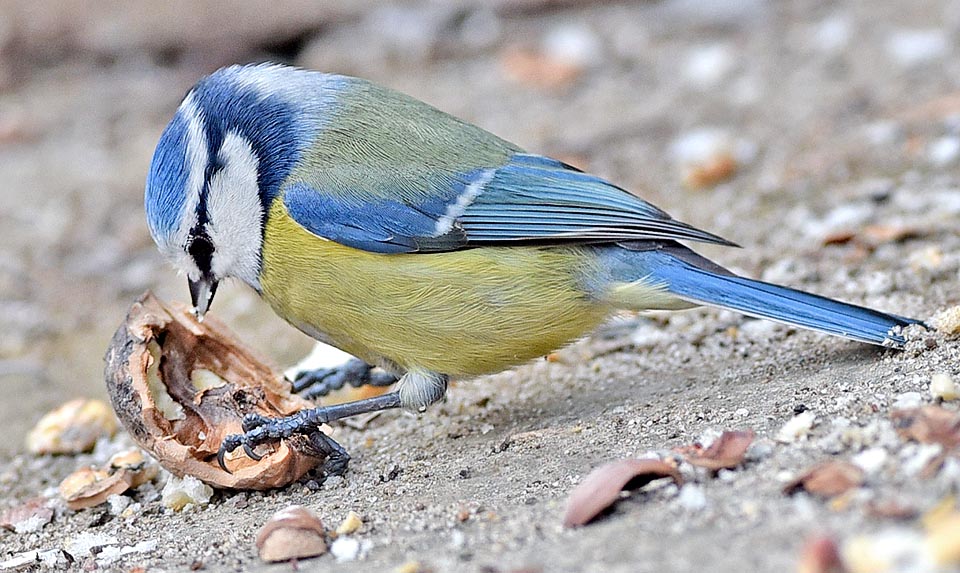Family : Paridae

Text © Dr. Gianfranco Colombo

English translation by Mario Beltramini

The Cyanistes caeruleus does not have a vast territory like the consimilar tits but occupies Europe extensively, south-western Asia and North Africa © Alain Ghignone
It is well known that Giovanni Pascoli did love the nature and in every poem written he used to amply describe colours and shapes, sounds and movements, behaviours and songs but also the species, stating clearly their name, proving to know in detail the nature that surrounded him. In one if his poems we have seen him mentioning the Great tit (Parus major), in another the Scops owl (Otus scops) then the Little owl (Athene noctua), the Swallow (Hirundo rustica), the Chaffinch (Fringilla coelebs) and so many others.

Just 12 g, but a real outsider as intelligence, perspicacity and intuition © Gianfranco Colombo
Therefore, it is not strange to read about the blue tit in one of his short texts: “And the thicket seemed a hiven full of flutterings and of hummings. But she heard also a rummaging, a stripping of foliage, a walking. Who will it be? But while she was looking into a rare bush, suddenly the blue tit sung”.
The Eurasian blue tit (Cyanistes caeruleus Linnaeus, 1758) belongs to the order of the Passeriformes and to the family of the Paridae, species previously assigned to the genus Parus.
This tit is a real outsider for the intelligence and even more for the perspicacity and insight.
Its innate curiosity is proved since its early youth with continuous experiences developed by poking around in every corner, in all the holes, pecking and tasting every material met, listening to sounds and songs and even the same noise of its own bill while thumping seeds and woods.
It is in this way that it learns how to know if a berry contains an insect, if so, it pierces the same, for eating or if a bark gives signs of emptiness below or if the chrysalis it has discovered is or not inhabited.
It has been the first to discover the way of nourishing of the milk cream emerging from the bottles left every morning on the doorstep by the English milkman, breaking the foiled seal and pecking its contents.
Habit unluckily forgotten after the advent of the new sealed Tetrapak packages and of the commercialization of skimmed milk. But it is always the one who has taught its consimilar, great tit included, this intricate mechanism thanks to its sound sociality that leads it to inform the whole world emitting a song for each typology of behavior and it is always the first to discover the roosts placed in the gardens with the food for the small birds.

Cyanistes caeruleus has been the first to discover how to eat the milk cream emerging from the bottles left every morning on the doorstep by the English milkman, breaking the foil seal and pecking the contents. And it is always the first to discover and signal the perches placed in the gardens with the food for the birds © Antino Cervigni
Its vocal repertoire is such to have available sounds for every occasion, from the signal of a predator to the call of contact, from the announcement of having found food to that quite particular of early warning to inform about the arrival in its own territory of a Robin (Erithacus rubecula) or of a Redstart (Phoenicurus phoenicurus), not real aggressors but surely not appreciated intruders. And it distinguishes them and informs all about this. The curiosity and the will to learn, leads the blue tit to take advantage continuously of its very small bill, transforming it from time to time in a specialized tool like a real hand or in a sharpened nose. In the bill it has placed those capacities not always displayed by its senses.

Here bathing, always alert and attentive. Cyanistes caeruleus has a vast vocal repertoire with a sound for every occasion; signalling a predator, contact call, discover of food or warning all of the entrance in own hunting territory of a robin or a redstart, not true aggressors but surely unwelcome intruders © Antino Cervigni
Always in England, they have noted its passion in tearing small pieces of newspaper, the petals of fake flowers but also tapestries of the walls of abandoned houses or the packings of the parked cars and even the Christmas decorations installed on the Christmas tree. What is sure that nothing goes unnoticed to a so curious bird like the blue tit! The etymology of the scientific name is rather unique. The genus Cyanistes comes from the Greek “kuanos” = dark blue and was previously considered as a subgenus of Parus, whilst the species caeruleus comes from the Latin and means pale blue, azure.

A little shake then rummaging between branches, hanging with a leg, head down, in acrobatic postures © Antino Cervigni
An unconscious and imperfect interpretation of old linguistic terms to indicate the real colour of this small bird seen that it absolutely misses the dark blue and is recalled for its elegant and light colouration of pure and ethereal light blue colour.
On the other hand, this nomenclature has given space a few decades later, to the classification of the Azure tit (Cyanistes cyanus Pallas, 1770), thus increasing the confusion seen that in this small bird the light blue colour is even more marked.
Confirming its real colour, it is called in the various languages as follows: Blue Tit in English, Blaumeise in German, Herrerillo Común in Spanish, Mésange bleue in French, Cinciarella in Italian and Chapim-azul in Portuguese.
Zoogeography
The blue tit is usually sedentary though some populations that occupy the northernmost ranges, make short but periodical displacements towards lower latitudes to avoid the rigours of winter.
In any case it performs some erratic movements of few kilometers that interest the descent of specimens from the mountain areas towards the underlying valleys and bound to habitats that can guarantee food during the bad season.
The blue tit does not have a so vast territories like the consimilar tits and occupies only, but extensively, Europe, the south western part of Asia and North Africa.
In Europe it is absent only in Iceland, in the extreme north part of the Scandinavian peninsula and in CisUralic Russia. In Asia, it lives in Anatolia, the Caucasian area, and the other mountain areas of Iran.
In Africa, from Morocco to Tunisia. It is present also in the Macaronesian islands, with some subspecies. In Italy it is amply diffused all over the territory excepting the highest peaks of the Alps.
Ecology-Habitat
The blue tit lives mainly in mixed forests of hardwoods preferring more than any other essence, the oaks and the birches but it can be found also in orchards, briars, cultivated countries with small woods, city parks and in the rural villages. It does not love the barren and not treed zones being essentially an arboreal species but also for avoiding predations.

To survive a blue tit mist gobble not less than 10 g of food per day, almost its weight! The main food in summer is of animal origin: caterpillars, chrysalids, aphids and small spiders, whilst in the rest of the year, when there are no chicks to feed, it eats also seeds, fruits and berries © Gianfranco Colombo
While being a species that loves the hilly zones, where it reaches the maximum density, it is found indistinctly in plain as well as in high mountain, proving to be able to adapt to any geographic situation. A proof is also the always more important diffusion in inhabited sites, often coinciding with the increase of the nest boxes placed in the public and private gardens. The conquest of this new habitat is a continuous struggle with its consimilar great tit, bigger and more aggressive and competitor in the feeding as well as in the occupation of the nest boxes.

Here struggles with a big sunflower seed but the very small bill is always an adequate tool: a sort of hand, a fine nose or a precision drill © Gianfranco Colombo
The blue tit is however very social outside the nesting period and frequents assiduously groups of consimilars and not, from Long-tailed tits (Aegithalos caudatus) and Short-toed treecreepers (Certhia brachidactyla) to small Chiffchaffs (Phylloscopus collybita) and Goldcrests (Regulus regulus) but even the great tits too with whom reconciles during the bad season.
Morpho-physiology
The blue tit is very small, and in fact it is only 11 cm long, has a weight just reaching the 12 g and a wingspan of 18 cm. It is one of the smallest members of the group of the tits.
The livery, the attitude and the usual sociality, recall in outline those of the great tit even if being much more delicate and pale in the colours and more acrobatic in the movements.
The plumage evidences a nice lemon yellow on the chest, the belly and undertail that stops with a neat separation at the height of the neck. Cheeks, front and temples are very white and emphasize a black superciliary line that from the bill wraps the head to join on the nape with a belt also bluish black.
On the chin it has a black triangular spot with bluish reflections that goes down briefly on the throat stopping in contact with the yellow of the chest whilst on the head stands out a hood of a quite beautiful light blue colour that often is raised like a small crest when excited or in danger.
The shoulders display an olivaceous yellow mantle, compact and delicate, that contrasts with the primary coverts and the remiges that assume the pale light blue of the hood. These last are crossed by a fairly marked white line, formed by the extremities of the primary coverts. The tail, well pronounced even if reduced, is also light blue in perfect harmony with the alar cover. The eyes and the legs are black whilst the bill is pearly grey. This last is extremely small and conical, less elongated than the other tits but in the mean time strong and robust.

Exceptional deposition with 13 eggs. Usually they are 7-10 and Blue tit can have two broods per year © Museo Civico di Lentate su Seveso
There is no evident sexual dimorphism apart a sometimes more accentuated shade in the colours of the male but scarcely visible on the field. Conversely, the young have more lively colours with a warmer and more intense yellow on the chest.
Also for the blue tit have been classified various subspecies, two of which, the Cyanistes caeruleus raddei and Cyanistes caeruleus persicus, are peculiar to Iran, the easternmost part of the range, the Cyanistes caeruleus satunini of Caucasian area, the Cyanistes caeruleus orientalis of European Russia and the Cyanistes caeruleus caeruleus peculiar to Europe.
Other subspecies concern populations relegated in insular sites that have had evolutions, though minimal in the livery, such as the Cyanistes caeruleus obscurus of the British Isles, the Cyanistes caeruleus balearicus of the Balearic Islands, Cyanistes caeruleus calamensis of the Aegean islands and the Cyanistes caeruleus ogliastrae of Sardinia, Corsica and part of the Iberian Peninsula.
Ethology-Reproductive Biology
The blue tit is a real acrobat when it rummages between the branches of a tree looking for insects. It hops from branch to branch, rotates and turns upside down, hangs downwards clinging with a leg and using the other for holding the berry where it has discovered a small caterpillar, drops dead weight to seize a twig a few feet below and then again a short flight to reach a higher branch. In short, a real funambulist.

The female builds the nest and broods. The male helps in the chicks demands © Museo Civico di Lentate
Its main food during the summer season is of animal origin: caterpillars, chrysalids, aphids and small spiders, whilst during the other periods of the year it eats seeds, fruits and berries.
The incessant activity of looking for insects in every moment of the day comes from the fact that for surviving the blue tit must gobble not less than 10 g of insects per day, more than the 50% of its total weight to add then from the incidental necessities for feeding the numerous progeny.
From the food placed in the mangers placed in the gardens, prefers the sunflower seeds that it rapidly takes from the perch and carries on a nearby twig where, with patience and force, will pierce the shell to take its contents.
The blue tit is a precocious nester and already from the month of February begins the courting with unceasing songs and with the first matings.
The nest is built only by the female inside fissures of the walls, in holes of trees, in stone walls, in cavities of whatever kind even not high from the ground and often in the artificial nests. The niche can be used repeatedly in the following seasons renewing partly the material once the repeated use has completely filled up the cavity.
The nest is done with wool and hairs, with lichens and mosses, with feathers and fibres, to form a shapeless heap inside which is formed a soft cup where are laid 7 to 10 whitish eggs dotted diffusely but lightly with reddish small dots.

The blue start is usually sedentary even if some populations make short but periodical movements towards lower latitudes for avoiding the winter rigours © Luigi Sebastiani
The brooding, done by the female, lasts about 15 days and the chicks leave the nest after three more weeks cared with love by both parents. It usually lays two broods per year.
The fact that the blue tits have a very varied and developed language is well known since ever but it would seem incredible that among the sounds emitted they are able also to hiss like a snake.

When the insects are scarce also this nut may be a precious food … and then, as everybody knows, nuts are good for the brain © Gianfranco Colombo
This is simple to verify, it is sufficient to peek into the nest while the female is brooding and immediately the landlady in order to frighten the intruder begins to hiss at once, like a real snake!
Populations of Cyanistes caeruleus are increasing, and since 2016 it has been listed as “LC, Least Concern” in the IUCN Red List of Threatened Species.
Synonyms
Parus caeruleus Linnaeus, 1758.
→ To appreciate the biodiversity within PASSERIFORMES please click here.
